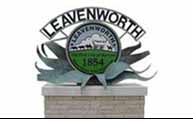Begin south of town on Kansas 7/U.S. 73 highway and head North.

As you drive
North through Lansing, you will pass the Lansing Correctional
Facility. The land was purchased as the proposed site for the
prison in 1861, and construction was started in 1864. Located
on the prison grounds is an 1887 Atchison, Topeka and Santa Fe
Railroad freight depot that the Lansing Historical Society is
restoring into a museum. The museum will display numerous Lansing
Artifacts.

Next you will
pass Saint Mary College on your left. The Sisters of Charity of
Leavenworth, who operate the college, first came to Leavenworth
in 1858 and opened an orphanage and academy for young girls. In
1870 they moved their academy from a downtown location to its
current 240-acre campus. In 1923, the sisters founded Saint Mary
College, now a coed, four-year college.

Across the
highway and just North of Saint Mary College is the Dwight D.
Eisenhower Department of Veteran Affairs Medical Center, once
known as the "Old Soldiers' Home." In 1884 the 640-acre
plot was selected and two years later 17 buildings had been completed,
including a dining hall that could seat 1,200 minimum. An information
center is located at the gate.

The large
building dominating the north end of the grounds is the main hospital,
built in 1933. The highlight of the VA is the Chapel of the Veterans,
built in 1893. This Gothic building with its gargoyles and stained
glass windows was called the "Believe It or Not" Chapel
when it was written up by Robert Ripley many years ago. It was
said to be the only house of worship where Protestant and Catholic
services could be conducted simultaneously under one roof. It
is open to visitors year round.

Leaving the
Veterans Affairs Medical Center and continuing North on Highway
7-73 you will turn left on Spruce Street. Drive west on Spruce
until you reach Fifth Avenue - there is a museum sign to follow
- turn left and you will find the Carrol Mansion on your right
at 1128 Fifth Avenue. Usually a host or hostess with be available
to talk about the beautiful 16-room mansion, built in 1867. The
rooms are furnished in mid-Victorian style with heirlooms of the
era. One room, named the Leavenworth History Room has pictures
and articles on local distinguished citizens.

The museum
is open May through August, Monday through Saturday, 10:30 a.m.
- 4:30 p.m., Sunday, 1-4:30 p.m.; September through April, Daily
1:00 p.m. - 4:30 p.m. Closed in January and major holidays. Admission
is charged. Call the museum at (913) 982-7759 for information
or to arrange a guided tour for groups.

Across from
the museum on southeast corner, is a large white house that was
the home of Judge David J. Brewer. Brewer was first Supreme Court
Justice appointed from Kansas.

Drive back
North on Fifth Avenue, cross Spruce Street to Seventh and Olive
streets where you'll see the former Home of Fred Harvey, the famous
restaurateur. Harvey established a network of restaurants, first
along the Santa Fe Railroad and later at stations on other lines.
The Harvey Houses, with waitresses known as Harvey Girls, set
a standard of excellence for food and fine service in a part of
the country previously know for its gastronomic tortures! Harvey
also developed the dining car system on on American railroads.

In 1883, he
purchased the house for $25,000. At that time, it had porches
and gothic dormers on the exterior, and several fireplaces inside.
The National Fred Harvey Museum will be housed in his former home
in 2002.

Return to
Spruce Street, turn right and proceed to Broadway, the first lighted
intersection. Travel north on Broadway to see some of Leavenworth's
most beautiful and historic homes. (These are private residences
not open to the public.)

The Queen
Anne baroque home at 714 S. Broadway was built in 1885 and has
been completely restored. It has 21 rooms, nine fireplaces, five
full baths, 44 stained glass windows and a completely finished
attic once used as a ballroom. In addition to the 9,000 square
feet of the main house there is a beautiful 2,750 square-foot
coach house in the back.

Further north
at 600 S. Broadway is a house built on nearly five acres in 1876
of soft brick. Around the turn of the century, a layer of stucco
was applied over the brick.

The home at
508 S. Broadway was built in 1868 in what was originally called
Italian Mediterranean style with a predominately vertical line.
In 1914, however, a new owner added the extensive porches with
the heavy stone work. The interior is highlighted by exposed wood
beams, walnut paneling and marble. The swimming pool was located
in the large coach house. Brigadier General "Fritz"
Gruber, Commandant of Fort Leavenworth, died here in 1941. He
was the author of 'Artillery Song,' now known as the Army song.

At 410 S.
Broadway you will find the Clark House, which was built in 1869
by A.M. and F.M. Clark, early Leavenworth bankers. They had a
branch bank in Denver where they minted coins. That portion of
their operation was bought by the U.S. Government and became the
Denver Mint. The home was restored just a few years ago. Old photographs
were used to guide the reconstruction. The alcove on the north
side of the house remains where string ensembles would sit to
entertain guests.



